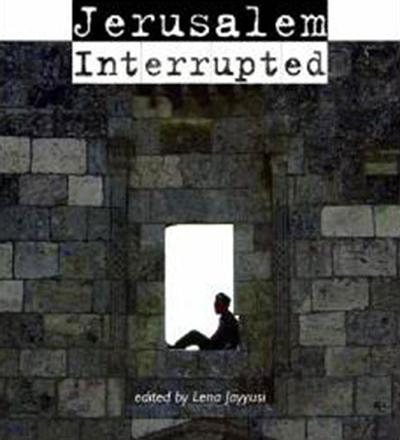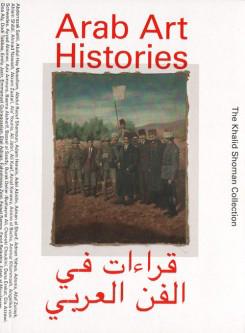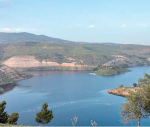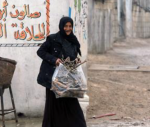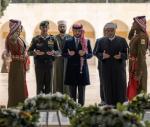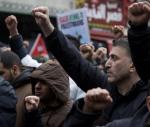You are here
‘Where the sun has burned out…’
By Sally Bland - Dec 21,2014 - Last updated at Dec 21,2014
Syria Speaks: Art and Culture from the Frontline
Edited by Malu Halasa, Zaher Omareen & Nawara Mahfoud
London: Saqi Books, 2014
Pp. 312

“Syria Speaks” is a compilation of personal narratives, short fiction, essays, poetry, song lyrics, posters, art works and photos that express the thinking and experience of the democratically-minded Syrians who sparked the initial nonviolent phase of the 2011 uprising, before it was overtaken by regime brutality and religious extremists.
Motivated by the editors’ conviction that “creativity is not only a way of surviving the violence, but of challenging it”, the book reasserts the uprising’s original progressive cultural identity. (p. vii)
The contents are touching, inspiring and enlightening.
If the current situation is horrifying and sometimes difficult to decipher from outside, imagine the soul searching of the mostly young people who once hoped for something quite different.
Many of the contributors recall the regime’s past repression from Hama in 1982 to the death from torture of political prisoners, drawing parallels to the thousands now killed or imprisoned, and the wholesale destruction of villages, towns and cities across the country. Others focus on cultural production and grass-roots efforts to bolster popular resistance and create a new, revolutionary, non-sectarian identity.
Researcher Hassan Abbas contributes a thoughtful essay on how the regime cultivated the culture of sectarianism in response to the uprising, whereas the opposition seeks to develop a culture of citizenship of which freedom is the most significant element.
In his view, the revolution was “an exceptional act of citizenship that began by breaking the chains that had reproduced the culture of fear”. Citizenship has continued “in the work of thousands of Syrians who have performed relief work and provided medical, nutritional, educational and other forms of assistance to millions of displaced…” (p. 56-7)
In an interview with Malu Halasa, Assaad Al Achi explains the work of the Local Coordinating Committees that tried to spread the tactic of nonviolent civil disobedience and to organise the proliferation of citizen-journalists. Yet, within a year, the uprising had become fully militarised and this network turned into a relief and medical aid organisation.
Much of this interview is counterintuitive, such as the fact that communicating with the Arab public is the hardest, since “Arabic media channels are much more propaganda-driven than Western channels”. (p. 110)
An article by Omar Alassad explores new forms of alternative media and the importance of the Internet and mobile phone cameras in getting news out to the world. A section of the book is devoted to the work of Lens Young, citizen-photographers whose striking photos, document the destruction of homes and lives.
Other chapters review the literature of the uprising which comprises both established and new writers, the role of the intellectual, filmmaking and the political finger puppetry of the Masasit Mati group.
The art included in the book ranges from professional work to street art, such as graffiti and banners. The influence of Palestinian resistance art is apparent in some of the latter.
At the sophisticated end of the spectrum are the works of Sulafa Hijazi and Khalil Younes — graphic, even shocking, protest art against killing and the social effects of militarisation.
Like a number of other contributors, Hijazi has since left Syria. She says: “There are still many courageous people working inside the country, but their numbers are becoming fewer and the sound of weapons drowns out the voices of peaceful activism.” (p. 13)
A novel feature of the uprising has been the formation of artists’ collectives producing posters for public display with basic materials, such as Kartoneh in Deir Al Zour, Alshaab Alsori aref tarekh and Syrian Revolution-Kafranbel.
The inventive metaphor, sly wit and satire apparent in their creations are addressed in Zaher Omareen’s article on “The Symbol and Counter-Symbols in Syria”: “It is no longer acceptable to make representations of concepts of freedom, justice and dignity using the same methods, language and techniques that the Assad regime’s propaganda employs. The revolutionaries tend to shun such banal and craftily abusive conceptual slogans.” (p. 101)
Outstanding examples of powerful symbolism are seen in Ali Ferzat’s political cartoons, Samara Sallam’s photo of birdcages waiting to be opened, and other pieces.
Poet and filmmaker Ali Safer describes Syria as “a nation where the sun had burned out”. (p. 131)
Yet, this book gives a ray of hope: If ever the killing stops, perhaps a space will open for Syrians, such as those who contributed to this book, who have constructive ideas for rebuilding their society in a democratic fashion. This book is an attractive and poignant testament to their vision and cultural abilities if only these could be translated into viable politics.
Related Articles
Shifting Sands: The Unravelling of the Old Order in the Middle EastEdited by Raja Shehadeh and Penny JohnsonUS: Olive Branch Press/Interlink
Focusing on the city which many consider to lie at the heart of the Palestinian-Israeli conflict, this book presents a panorama of real life in Arab Jerusalem, particularly during the British Mandate years — and how it abruptly changed in 1948.
Like both Darat Al Funun and the Khalid Shoman Collection which it covers, this book is firmly grounded in Amman, but at the same time indicative of a regional cultural network with international outreach.


